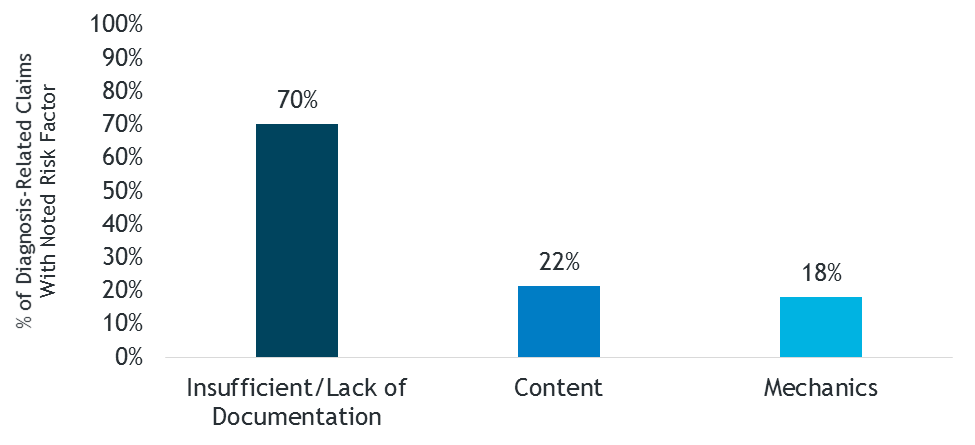The Role of Documentation in Diagnosis-Related Malpractice Allegations
Laura M. Cascella, MA
Allegations associated with diagnostic errors — i.e., wrong diagnoses, delayed diagnoses, and missed diagnoses — are a top cause of malpractice lawsuits. A number of risk factors can lead to diagnostic errors, including issues related to documentation of clinical care.
MedPro Group’s closed claims data from 2007 to 2016 show that documentation issues occur in almost 1 in 5 diagnosis-related claims. These issues generally fall into three categories: (1) insufficient/lack of documentation, (2) content, and (3) mechanics.
Documentation as a Contributing Factor in Diagnosis-Related Claims
Source: MedPro Group closed claims, 2007-2016
When it comes to defending malpractice claims, accurate and thorough documentation of the provision of clinical care is crucial. Thus, understanding the types of documentation missteps that contribute to diagnostic errors can help healthcare providers assess their current processes and adjust as necessary to reduce liability.
- Insufficient/lack of documentation. Among the categories represented in the previous graph, insufficient documentation dominates. Examples of situations that can lead to documentation deficits include:
- Failure to document attempts to follow up with a patient about care or test results.
- Failure of the healthcare provider to document that he/she has been involved in a patient’s care.
- Missing documentation in the patient’s record (e.g., patient problem list, test results, consultations, referrals, signatures indicating review, or medication lists).
- Failure to document adequate details about the patient encounter, which might be particularly problematic in an electronic health record (EHR) system because of reliance on form fields and check boxes.
- Content. Content-related concerns include problems such as altered documentation (which might suggest an attempt to cover up mistakes), opinions stated as medical facts, inappropriate comments or speculation (e.g., subjective vs. objective information), the proliferation of inaccurate information as a result of the copy/paste function in EHRs, or general inconsistencies in documentation patterns across records.
- Mechanics. The mechanics category refers to inaccurate documentation within a factual setting. Examples include inaccuracies in transcribing or writing orders, illegibility (including the use of nonstandard abbreviations, shorthand, or “text talk”), delays in documenting, and failure to use an appropriate method for correcting documentation errors and making amendments.
Documentation Risk Tips
Because of documentation's essential role in healthcare, following best practices and standards is crucial. The following key risk management strategies can help ensure adequate and appropriate documentation.
- Ensure your organization’s documentation policies require providers to document:
- Sufficient details related to the patient’s history and physical exam. This documentation will help support continuity of care and comparison of findings from previous visits.
- Patient compliance, including missed and cancelled appointments and attempts to follow up with the patient. Providers should be careful to remain objective in their documentation and avoid editorializing.
- Treatment plan changes, such as receipt of diagnostic results, follow-up with the patient, patient response, and phone conversations (including after-hours calls).
- Consultations and referrals, including conversations with the consulting provider, agreed-upon consulting arrangements, and receipt and review of consultation reports.
- Patient education, including written and verbal advice, recommendations, and educational materials — as well as patient understanding of the information.
- Establish appropriate timeframes for completion of documentation following patient encounters.
- Consider whether documentation in the record supports clinical judgment and decision-making, and whether it clearly identifies how a particular diagnosis was determined.
- Do not include incident reports or criticism of other providers in patient records. Root cause analysis of errors and near-misses should be documented as part of the practice’s risk management and quality improvement efforts.
- Understand and educate staff about the appropriate methods for correcting or amending documentation.
- Ensure that documentation policies address issues unique to electronic documentation, such as the use of copy/paste, form fields, check boxes, etc.
For more helpful documentation strategies, see MedPro’s Documentation Essentials and Electronic Documentation checklists.




